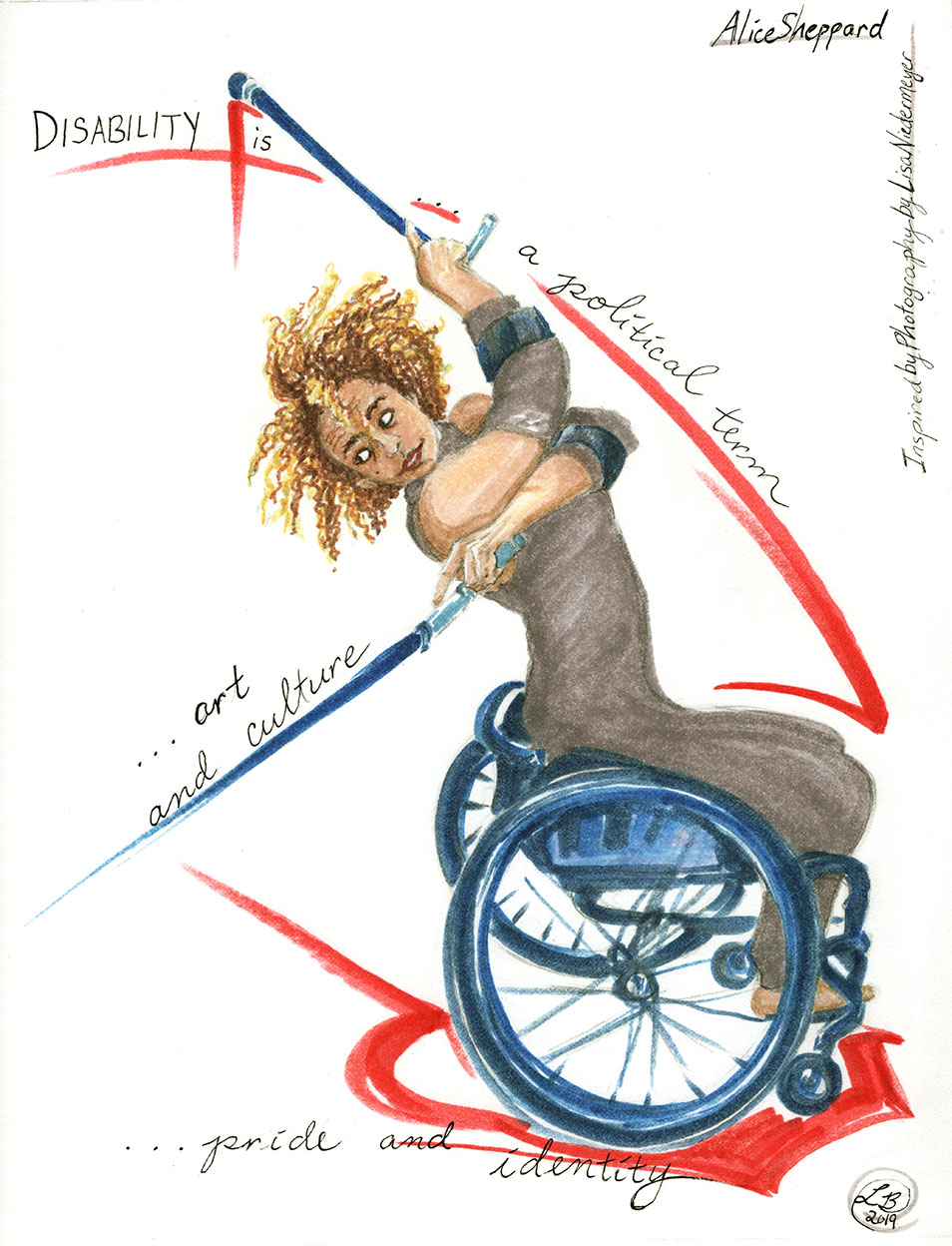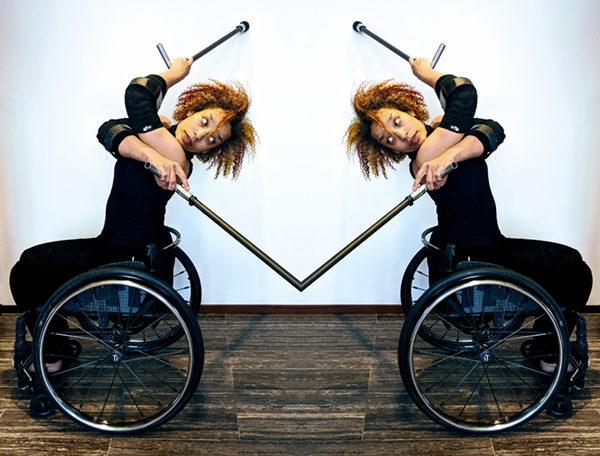Alice Sheppard: “I Want to Build a Network of Legacy”
BY EMMALY WIEDERHOLT; ILLUSTRATION BY LIZ BRENT-MALDONADO
After taking her first dance class on a dare, Alice Sheppard resigned her academic professorship to pursue dance. As a member of AXIS Dance Company, she toured nationally and taught in the company’s outreach programs. Since becoming an independent artist, Alice has danced with Marjani Forté, MBDance, Infinity Dance Theater, Steve Paxton, Full Radius Dance Company, and MOMENTA Dance Company, and has been commissioned by CRIPSiE, Full Radius Dance Company, and MOMENTA Dance Company. She is the founder and artistic director of Kinetic Light.
To learn more about the Discussing Disability in Dance Book Project, visit here!
Image description: Alice is depicted facing to the right side of the frame in her wheelchair, leaning back and looking upward and right. Her arms are crossed and her crutches extend from either arm. She is portrayed as smiling softly. Red streaks of energy surround her along with the quotes, “Disability is…a political term…art and culture…pride and identity.”
~~
How did you get into dance and what have been some highlights in your dance history?
I earned a doctorate in Medieval Studies at Cornell University and then taught English and Comparative Literature at Pennsylvania State University. In 2004, after a conference on disability studies, I took on a dare from disabled dancer Homer Avila to take a dance class. I loved it and took the AXIS Dance Company summer intensive workshop. The first lessons I took in ballet and wheelchair technique were taught by Kitty Lunn of Infinity Dance Theater. My first performance was with Kitty at the Joyce Soho. From there, I continued lessons with AXIS Dance Company, became an apprentice in 2006, and became a company member in 2007. I toured with the company nationally and taught in their education and outreach programs.
In 2012, I became an independent dancer and choreographer and have since worked with companies in the United Kingdom and the United States. A couple years ago, I initiated Kinetic Light, a collaboration with dancer Laurel Lawson and lighting/video artist Michael Maag. Michael, Laurel, and I toured DESCENT, our first evening-length work, choreographed by me in collaboration with Laurel, featuring an architectural ramp that acts as a partner in the choreography and storytelling. The ramp was designed by Sara Hendren, Yevgeniya Zastavker, and students at Olin College.
The history of disability and dance in the US goes back a long way, but the dance world does not know it. I want to build a network of legacy by naming the disabled dancers who have influenced me: Stephanie Bastos, Rodney Bell, Marc Brew, Laurel Lawson, Bonnie Lewkowicz, Kitty Lunn, and Judith Smith. Because of the relative newness of the field and the subsequent deficit of training and educational opportunities, most of my developmental thinking comes from a cross-disciplinary approach, including disability scholars and artists Eli Clare, Rosemarie Garland-Thomson, Georgina Kleege, Riva Lehrer, Simi Linton, and Tobin Siebers. These people have shaped not only how I think about movement, but how I understand the value of disability in the creative process.
How would you describe your current dance practice?
My dance practice involves a lot of research and thinking about the culture of disability. I look at other works being done by disabled culture-makers. My movement practices are scattered at this point. I take mainstream modern dance class and the occasional ballet class. I also swim, go to the gym for strength training, and do yoga.
My movement practice is also rooted in my relationship to technologies, and not just technologies that I use like my wheelchair or crutches, but also technologies around us. I mix mainstream dance vocabularies, the identity of impairment, and the relationship of disability arts and culture to technology.
When you tell people you are a dancer, what are the most common reactions you receive?
If it’s non-disabled people in the non-dance world, I tell people that I use my wheelchair to be a dancer, or I say that I’m a disabled dancer who uses a wheelchair. By putting my disability front and center, I immediately get around whatever people’s expectations are.
If I’m lucky, they’ll say, “Oh, like AXIS.” And I’ll reply that yes, I was an AXIS dancer for five or six years, and I’m making my own work now. The only thing many people may have heard of with regards to disability dance is AXIS. I’m proud to have been with AXIS, but I’m making my own career now, and I’m my own artist.
The United States has not yet nourished its independent disabled artists. There’s a strong repertory company scene that’s developing, but there’s not a strong scene of disabled independent artists. The UK is ahead of the US in that regard. It’s a question of funding. Individual disabled artists can get funded to make work at a professional level there.
What are some ways people discuss dance with regards to disability that you feel carry problematic implications or assumptions?
Most dance writers are not literate in wheeled, crutch, or disabled movement. And many are not familiar with the work of other companies and artists in the field. This means that they have less context for evaluating the choreography and the dancers, so they end up relying on what they know about other dance techniques. This is why they often respond to what is visually spectacular. They project what they imagine someone with a disability should or shouldn’t be able to do. It gets to the point where we’re not really talking about the movement on the dancers’ bodies; we’re talking about the writer’s uneducated perspective on disability movement.
Part of the difficulty is that we’re dealing with societal imaginations of disability as a lack of ability. Disability as identity, culture, politics, and aesthetic are not as familiar to people outside the disability arts world. So, people turn to what they know: disability as a lack of ability. Because of this, critical writers often don’t recognize or understand the traditions and training behind the choreography. They don’t have the cultural wallpaper. They lack cross references, and thus are unable to detect patterns of influence, innovation, or work that references other works.
Use the internet. See other pieces. Look at work samples. Read other reviews. Find out what the appropriate language is. I once read an article where an African dance choreographer challenged one of the New York Times writers on the notion of ignorance. The choreographer said something in response to a review along the lines of, “You may say that this piece wasn’t innovative, but you’re not familiar with the fundamental African forms that would enable you to recognize innovation.”
I know that everyone has no time and is over committed, but I would recommend writers be up to date on disability language and culture as much as possible.
Do you believe there are adequate training opportunities for dancers with disabilities? If not, what areas would you specifically like to see improved?
Of course not. Here’s what I envision: First, I want dancers with disabilities to be able to get training like any other dancer. That includes training in the major techniques and somatic practices, as well as the history and notable works. I want people to be able to have coursework on physically integrated dance and study work by disabled artists. There’s no reason that education in the field of dance and dance history shouldn’t be made available to disabled dancers.
Second, I want dancers to be able to be trained in the movement expressions and cultures of their own impairment. If you go to a mainstream dance class, the teacher probably won’t teach you how to use a wheelchair, but there is technique to using crutches or a wheelchair. There are also techniques to figuring out what blindness brings to dance. Deaf dance is its own art form. Right now, most disabled dance artists end up figuring most things out for themselves, but there are specific principles that can be shared among people who have the same impairment.
Finally, I want every dance teacher at the university level to be trained to teach physically integrated dance and disability dance. Disabled dancers should be able to go to a conservatory or get a BFA or MFA. Teachers should be versed in disability scholarship and be contributing to that scholarship.
Would you like to see disability in dance assimilated into the mainstream?
That’s like saying to an African American choreographer, “Should dance be whitened?” We must recognize that physically integrated dance is an art form in its own right. We wouldn’t try to “assimilate” ballet, modern, or hip hop. An art form deserves its own place in the field. Then, the question of assimilation goes away. Art forms need to be supported rather than mainstreamed. The pressure on a disabled person is already to join the mainstream and erase the disability.
What is your preferred term for the field?
I like being called “disabled artist.” “Physically integrated dance” is the accepted term in the US for the work being done by companies like AXIS, Full Radius Dance, and Dancing Wheels. Terms like “mixed abilities” get away from the art form and look at the abilities of the dancers instead. The term sets us back by focusing on ability instead of art. As Judith Smith used to say, “It makes you wonder about the mixed abilities; who are the good dancers, and who are the bad dancers?”
The thing about “differently abled” is that, just because I use a wheelchair, I don’t have different abilities than others. I don’t have a superpower, for example. I understand that people who use terms like “differently abled” use them because of the stigma that’s often attached societally to disability as being a deficit of diagnosis. But disability is not a deficit of diagnosis. It’s a political term; it’s a term of art and culture, a term of pride and identity, a term used by scholars, artists, and activists. When you add this context and set of meanings, it changes everything.
In your perspective, is the field improving with time?
This conversation wouldn’t have been happening five years ago. There’s more awareness now. The field is growing. People are taking greater risks. I’m excited.
Pictured: Alice Sheppard in Where Good Souls Fear, Photo by Lisa Niedermeyer
Image description: In this mirror image, the two images of Alice face away from the center but look back at one another. Aliceis seated in her chair. Her arms are crossed and crutches extend from either arm, intersecting in the middle of the photograph.
~~
To learn more about Alice’s work, visit alicesheppard.com.
To learn more about the Discussing Disability in Dance Book Project, visit here!


